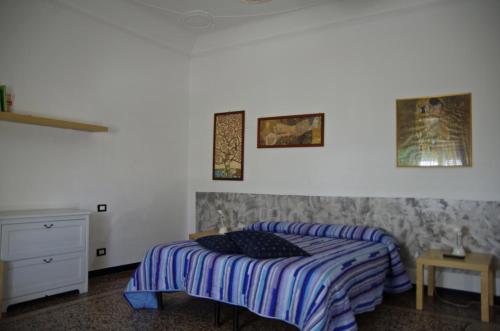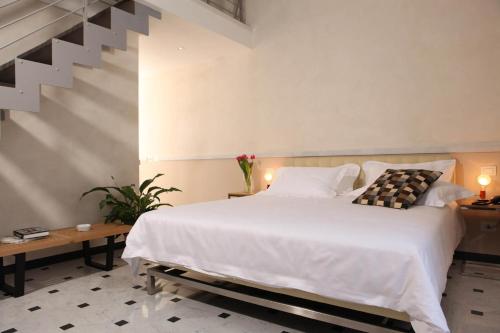Strade Nuove, Genoa Italy
Think about the city or town that you come from. Then think about the wealthiest people who live there – maybe the top 40 or 50 of them.
Then imagine that they all came together and agreed to take over one street of your city and build enormous grand homes for themselves on that street, right next to each other.
If you can picture that, then you’re on your way to getting a sense of what the Strade Nuove in Genoa, Italy, is like. Just make it ten times more luxurious and palatial than you’re imagining.
In the 1500s, there was a lot of money in Genoa as it flourished as one of Europe’s most important trading ports. The various families that controlled the money wanted somewhere special to live and, in partnership with the local political authorities, this stretch of street was allocated.
It’s called Strade Nuove (the new streets) now but it is technically made of up three streets – Via Garibaldi, Via Aurea, and Via Balbi. Along them, on both sides, dozens of grand homes were built.
Each of these palaces – for they really were palaces, rather than homes – was unique, reflecting the particular characteristics of the site and the interests of the owners. But there was also some consistency in the architecture.
The palaces were each 3 or 4 storeys high, with a large entrance hall with spectacular open staircases. They had elegantly-decorated public reception rooms and private residential areas.
Most also had courtyards and covered galleries with garden areas – although, unlike other Italian homes of the time like the Medici Villas, the emphasis was certainly on the interiors more than on the outdoor areas.
Palazzi Dei Rolli, Genoa
Although each of these grand palatial homes was individually owned, they also operated as a collective group of residences that had a public role. Together, they are described as the Palazzi Dei Rolli.
One of the main public roles of these homes was to host visiting dignitaries. Genoa didn’t have a royal palace of its own but, because of the city’s importance, there were a lot of state visits here.
So the families of the Palazaai Dei Rolli took turns providing accommodation, meals and formal receptions when heads of state and other important envoys were in town. The higher a guest’s status, the nicer the palace that was chosen for them.
Visiting the Palazzi Dei Rolli
Most of the palaces still exist today, spread along the Strade Nuove in Genoa.
Some are in private hands. Some are used for businesses like banks or shops.
And then there are a few that have been maintained as they would have been centuries ago – and they are open to the public.
I think the best way to get a sense of the Palazzai Dei Rolli is by doing a guided tour and I would recommend this excellent tour of the palaces.
To do it yourself, I would suggest going to three of them that are all in the same area and can be accessed with the same ticket. For just €9 (€7 for a reduced ticket) you can visit the Palazzo Rosso, Palazzo Bianco, and Palazzo Doria Tursi.
Palazzo Rosso
The Palazzo Rosso was built between 1671 and 1677. It was owned by the Brignole Sale family until 1874 when Maria Brignole Sale, duchess of Galliera, bequeathed it to the city of Genoa.
After you go up the large stunning staircase to the first floor, you’ll find a collection of rooms decorated with frescoes by the greatest Ligurian painters of the 17th century. There are precious furnishings, paintings, and other pieces of art.
The first floor gives you a bit of a sense of how the rooms may have once been laid out and how guests would have been entertained here. As you go up to the higher levels, there are some exhibitions that give an insight into the lives of those who were lucky enough to once call this home.
Make sure you catch the elevator up to the roof for incredible views across Genoa.
Palazzo Bianco
Across the road is the Palazzo Bianco, built between 1530 and 1540, which you’ll immediately realise has a much more imposing entrance. Going up the staircase in the foyer, you’ll get a sense of how large this building is.
The terraced garden out to one side if one of the highlights and there’s actually a lot of space here, compared to many of the gardens of the other palaces.
The Palazzo Bianco is used these days as more of an art gallery than a representation of its original interior layout. You will be able to see the rooms and admire how they are decorated – but mainly the focus is on the impressive collection of paintings and other art that is hanging on the walls.
Palazzo Doria Tursi
The Palazzo Tursi is right next to the Palazzo Bianco and you’ll actually access it through a corridor, rather than coming back out onto the street.
It has some monumental halls which you’ll be able to visit. The frescoes and designs of these rooms are stunning in themselves, but they are also used to display some of the treasures that the city owns.
The most important treasure in the collection is probably a violin made by Giuseppe Guarneri that was owned by Paganini (and is ‘priceless’ but has an estimated value of about $18 million!).
The Palazzo Doria Tursi has some of the city council’s offices in it and so has a more formal feel to it than the other residential-style palaces.
Overall, these palaces on Via Garibaldi are a highlight and one of the best things to do in Genoa.
There is a lot of detail in each of them – more than I think you can see on a single visit – and another good reason to take a tour of the palaces is so the guide can point out the highlights.
Genoa is still a wealthy city. It has the largest port in the Mediterranean and you can see the money pouring in. But it has changed a lot. I’ve also written a bit about the historic centre of Genoa.
There’s lots to see in the city and I would recommend one of these options to explore it properly:
For now, though, let’s cherish this view of noble life in the 16th and 17th centuries and that it has been so well preserved.
THE BEST ACCOMMODATION IN GENOA
While you may not be able to live in one of Genoa’s palaces, there are still great places to stay in the city.
BACKPACKER

For a great budget option, Ostellin has such beautiful rooms.
BUDGET

For an affordable room, B&B il Blu di Genova is clean and comfortable.
BOUTIQUE

If you’re looking for something stylish Hotel Le Nuvole Residenza d’Epoca has a very cool design.
LUXURY
And for luxury, the Meliá Genova has five star quality.
What a fantastic trip! It looks so royal and incredible view of Genoa, Italy. I really love your pictures, your pictures make me want to go there and visit this place as possible as. Keep posting!
Thanks so much! Yeah, even though royalty never lived in these palaces, they certainly look fit for a king, don’t they?!
I love the opulence and grandeur of all these palaces. Wow that would be amazing to sit in one of those chairs and just be surrounded by all that artwork on the walls.
I went into my visit expecting to only be looking at the building, so I was quite surprised to see all the art. I think, for that reason, I didn’t pay the pieces enough attention. It was only later I realised what a treasure collection there was!
Wow! They are so grand and oppulent, I cant even imagine what it must have veen like to live in one of them. It’s great that they are open to the public so that we can see what their like inside. Very interesting, thank you.
Yeah, a lot of them are in private hands (usually commercial) so it’s nice that there are a few that are completely open for the public like this.
Such beautiful interior and architecture. I would love to visit Genoa in Italy and Palazzi dei rolli. I would love to learn more about the history around it. It is amazing to see that it is so well kept for so many years 😀
I was impressed with how it had been preserved as well! It’s definitely a highlight of Genoa!
I seriously couldn’t stop staring at the photo of the bedroom. It’s super luxurious and the attention to detail is insane. I love how you described Strade Nuove. It really helped me envision how much money these people had to create this street (s). I definitely want to go here when I am in Italy!
Oh, I know! Imagine it was actually your house, and that was the kind of room you slept in! Maybe they should consider also using the building as a hotel in the evenings? 🙂
What a fun and interesting read on history in Strade Nuove, Genoa. I flew back from Italy today but that was to ski 🙂 I would love to go to Genoa it looks and sounds beautiful and love history. I didn’t know about it being an important trading port either. Btw The Palazzo Rosso is my favourite
the bianco is the largest heritage of the world that is be an historical landmaks and having the most lavish and beautiful looks … when i saw it first time i really got impressed with the way of construction and the design on the carvy walls that attract you a lot thanks for the author to share some best things
I know about the italy cities because this is my first country i was born in italy i know italy is most beautiful country. thanks to giving me memorables moment. now i am in dubai thats why i am missing my own country./
Genoa is still a wealthy city. It has the largest port in the Mediterranean and you can see the money pouring in
I’ve been only to Milan and Ravenna and this post makes me want to visit Italy again. Italy is beautiful!
Oh, there’s so much to see in Italy. Far too much for just the one visit! I hope you get back one day and can see some of these sites.
Hi, Michael. What a wonderful website. Can you suggest the perfect place for my son to propose to his wonderful girlfriend? They will be in Genoa next week. He would like to hire a professional photographer for the moment. Any suggestions for photographer as well? Maybe a company that specializes in special occasions?
I Love your content and I always admire